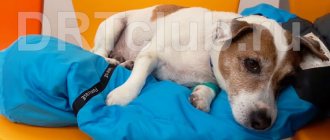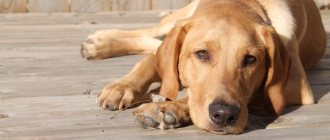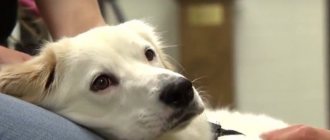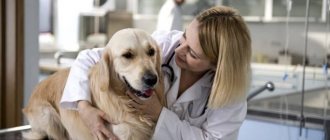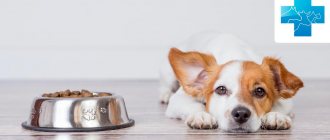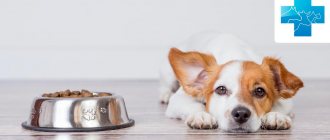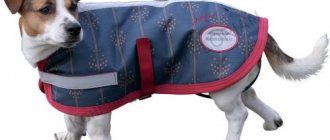Sterilizing a dog allows you to get rid of many negative aspects associated with the start of sexual heat in your pet.
After surgery to eliminate the reproductive function, the animal’s behavior changes, and there is no need to deal with the placement of puppies. In addition, the risk of developing dangerous diseases such as pyometra, malignant tumors of the uterus, ovaries and mammary glands is reduced.
If the preoperative preparation was carried out correctly, and the operation is performed by a qualified veterinarian, complications occur extremely rarely. Properly organized care according to the recommendations of a professional can speed up the recovery process after abdominal surgery.
Dog after sterilization on the first day
After sterilization, the dog recovers from the state of anesthesia for the first few hours. The animal comes to its senses gradually over the first 24 hours.
The dog needs proper care after sterilization, so it must be carefully looked after.
If there are disturbances in the breathing process (the animal is breathing heavily), problems with the pulse, changes in the shade of visible mucous membranes (cyanotic or anemia), changes in body temperature, this is a reason to immediately contact a veterinarian. Complications of this kind rarely occur if the operation was performed correctly.
In the first days, and especially the first 24 hours after surgery, the animal comes out of anesthesia, and the body actively removes narcotic substances, so it is not recommended to place the pet on high surfaces due to the risk of falling. The dog's bed should be located on the floor, away from drafts and heat sources. If the animal is cold, you can cover it with a warm blanket.
Immediately after your pet wakes up, you can give her some water. If the animal refuses, it is necessary to moisten the mouth and tongue with water. It is not recommended to give your dog food or other food for several hours after recovery from anesthesia. Small portions of food can be offered to the animal the next day.
On the first day after sterilization, the animal must receive painkilling injections prescribed by a veterinarian. This will allow your pet to survive the first 24 hours after abdominal surgery as comfortably as possible. It is also necessary to wear a special blanket to prevent the animal from licking the seams. There should be several blankets in order to promptly change them as they become dirty.
Castration of a bitch: methods of implementation
Castration can be surgical or medicinal.
Medical castration of a female
The dog is given a drug that causes the inability to conceive. Since the drug has a number of side effects, surgical castration is recognized as the main method of preventing pregnancy in bitches.
Surgical castration of a female
The operation is performed for 20-60 minutes under general anesthesia. The duration of the operation depends on the weight of the dog. Then the bitch continues to sleep for another 2 hours under anesthesia.
The length of the incision is 5-15 cm. The wound is sutured using absorbable material. The suture threads on the surface of the skin are removed on the 10th day. If the stitches are sutured with absorbable thread, the stitches do not need to be removed.
Which is better: castration or sterilization of bitches. Photo.
Caring for a dog after sterilization in the first month
In the first weeks after sterilization, to prevent stitches from licking and for their successful healing, veterinarians recommend putting on an immobilizing collar for your pet. Otherwise, the risk of pathogenic bacterial microflora entering and multiplying in the wound increases several times. The postoperative bandage is worn immediately after surgery. It is not recommended to remove it for the first 24 hours.
Sutures are removed 7-10 days after sterilization if the wound surface has successfully healed. It is necessary to regularly inspect the wound (morning and evening), but do not touch it. Successful healing is indicated by dry edges of the wound, as well as the absence of ichor around. In some cases, a slight swelling of the edges with gradual disappearance is considered a normal option during healing.
The owner must be vigilant in noting any changes in the animal's condition. The appearance of fever, discharge from the wound surface of blood, pus or other exudate is a reason to immediately consult a veterinarian. In the vast majority of cases, the cause of blood is damage to a small vessel rather than extensive internal bleeding. The appearance of purulent exudate indicates the penetration of infection and the proliferation of pathogenic microorganisms. In such cases, the veterinarian prescribes a course of antimicrobial agents.
Physical overexertion should not be allowed in the first month after sterilization. It is important to protect your dog from active games, running and long climbs up stairs. All kinds of jumping are also prohibited. When walking outside, you must keep your pet on a leash, not allowing it to run freely.
The first time after the operation to sterilize the animal, the pet will feel pain. Some dogs experience more pain, some less. A veterinarian should recommend and prescribe pain medications. They need to be injected for no more than 5 days. If the following symptoms appear, you should contact your veterinary clinic for advice:
- Refusal to feed for more than 2 days. Starting from the first day after recovery from anesthesia, your pet should have an appetite.
- Isolation of exudate from the wound surface. In normal condition, the postoperative suture should be dry. If you notice bloody or purulent discharge from a wound in your pet, you should consult a doctor.
- Stool upset, eruption of gastric contents. In some cases, painkillers prescribed to a dog after sterilization can cause irritation of the stomach lining.
- Severe lethargy and weakness on the 3rd day after surgery, swelling in the abdominal area.
Why is a bandage needed?
During surgery, the skin, subcutaneous fat, and abdominal muscles of the animal are dissected. To eliminate the possibility of postoperative hernias and quickly restore damaged body structures, the dog will need a special belt - a bandage. It helps maintain the abdominal muscles in the required condition and also prevents the animal from damaging the sutures. Depending on the situation, the bandage is worn from two days to two weeks. In the case of a laparoscopic procedure, a sterile dressing is used instead of a bandage.
Further care for the dog
After removing the sutures, it is necessary to monitor the animal’s behavior and its general condition for some time. Stress and physical overexertion should not be allowed. It is important to protect your pet from stress factors as much as possible.
If there are other pets living in the house, at first doctors strongly recommend limiting the operated female’s contact with them.
A special place in organizing proper care for a dog after sterilization is occupied by the preparation of a diet. It is known that as a result of ovariohysterectomy, the animal’s hormonal levels change, causing metabolic disorders.
Preparation
In a specialized and licensed clinic, the dog will be given an anamnesis indicating all previous diseases, the possibility of an allergic reaction, information about vaccinations and deworming.
To prepare for surgery, the animal will be tested for laboratory tests and an ultrasound of the heart and internal organs will be performed. 4 hours before the operation, they stop giving him water, and stop feeding him even earlier to avoid stress on the stomach, liver, and intestines.
The veterinary anesthesiologist takes into account the indications and selects the appropriate anesthesia for the pet. This could be a mixture of gases for inhalation anesthesia, an intramuscular injection of xylazine, or an intravenous injection of propofol.
Feeding the dog after sterilization
During the first time after the operation, the dog may experience constipation or, in other words, constipation. After the administration of special drugs during anesthesia and recovery from a state of deep sleep, constipation is part of the norm. Constipation can be painful for your dog, so the food should be high in calories but as easy to digest as possible.
It is recommended to give food in ground form and semi-liquid. If the dog does not want to eat, there is no need to force food into it. Long-term refusal to eat – more than 3 days – is a direct reason to consult a veterinarian.
It’s good if, after recovering from anesthesia, the dog shows a desire to drink plain water. But even if the animal does not want to drink for some time, there is no reason to worry. You can offer to drink water from a spoon or try to drink from a syringe without a needle. It is important at this moment to ensure that the animal does not choke.
Dog food after sterilization should be carefully selected by a veterinarian. He will be able to recommend super-premium medicinal food that will satisfy all the nutritional needs of the animal’s body without causing obesity. You should not save on feed, because the health of the animal directly depends on the quality of the feed.
Experts' opinion
Anatoly Kulagin, Novosibirsk: “Sterilization and castration is a necessary procedure for a dog if the owner does not plan to breed offspring. Anyone who considers a surgical procedure inhumane to an animal should understand that dogs do not experience pleasure from sexual intercourse. For them, this is just an instinct to procreate, and for the owner it’s an extra headache.”
Irina Alexandrova, Moscow: “Caring organizers of nurseries and animal shelters often come to our clinic. It is much easier to find a family for a sterilized dog, since people are usually afraid to have a pet precisely because of unwanted offspring. The procedure is absolutely safe if performed under the supervision of an experienced surgeon.”
Kirill Perov, Voronezh: “It is imperative to sterilize a bitch that has been bearing offspring for 5-6 years. This will increase her life expectancy, since pregnancy and childbirth greatly wear out the body.”
A responsible owner will always take care of the dog’s health and provide the new puppies with everything they need. But if there is even a small probability of unwanted babies being thrown out onto the street, it is worth considering sterilization as an urgent need.
Seam care
After a standard operation to sterilize an animal with removal of the uterus, ovaries and fallopian tubes, a sufficiently large wound surface remains. The suture needs to be properly treated, and the care of the suture itself depends on the type of suture material used by the veterinarian.
Self-absorbable threads are more often used to stitch the inner layers of the skin, and on the surface they use material that must be removed after time. It is recommended to treat seams with antiseptic solutions 2 times a day. For the first few days, the animal may have a lump on its abdomen at the site of the incision, indicating slight swelling. In normal condition, it resolves on its own.
It is important to carefully monitor the postoperative suture. If there is swelling at the incision site or restless behavior of the animal, this may indicate the development of complications or pain. A veterinarian will conduct an examination and prescribe pain medications to facilitate the rehabilitation process. In the vast majority of clinical cases, specialists prescribe antibiotics immediately, without waiting for the onset of inflammation. This allows you to prevent consequences and play it safe.
A properly healing seam is always clean and dry. If the suture bleeds, this is not the norm and indicates the development of pathology. The cause may be suture divergence or damage to small vessels of the epidermis. Heavy bleeding is rarely diagnosed. In any case, you should consult a veterinarian. You can even bathe your pet if necessary, but only if your veterinarian approves. As a rule, the dog is allowed to bathe no earlier than 25-30 days after surgery and successful wound healing.
Preparations for postoperative suture treatment
The veterinarian will tell the owner how to treat the surgical suture. Preparations for treating seams:
- Levomikol;
- Terramycin spray;
- Aluminum spray;
- Streptocide;
- Furacilin;
- Vetericin spray;
- Betadine.
Before applying the products, make sure that the healing process is normal. With normal healing, the skin will be dry, without redness, swelling, or bruising. The postoperative area should be clean and the sutures should have smooth contours.
What do owners expect after sterilizing their dog and how well are their expectations met?
The consequences of sterilization may also not be entirely expected for the owner. Some females may remain in heat after surgery. This is due to incorrectly performed manipulation - incompletely removed ovarian tissue, increased content of female sex hormones in the bloodstream.
There is an opinion that after sterilization, the dog’s character changes, it becomes more docile, calm and affectionate. The operation does not indirectly affect changes in behavior, since a physiologically healthy female is in a state of active sexual estrus only a few times a year. This means that the pet will not be under the influence of sex hormones for the rest of the year.
The behavior of a sterilized bitch changes in terms of dominance. It has been proven that in nature, females are dominant over males. After sterilization, this behavior may increase and the animal may become more aggressive.
Veterinarians do not rule out the occurrence of estrus after sterilization. But this is a one-time phenomenon associated with the circulation of sex hormones in the bloodstream. As soon as their concentration decreases, the manifestations of sexual hunting fade away.
Complications
Despite the fact that castration is not considered one of the most difficult operations, a number of complications can still arise after it. To minimize this risk, you must take into account the recommendations and advice of your veterinarian.
The following problems often arise:
- Sometimes in the first days the pet becomes constipated. In this case, you need to reconsider his diet. It should only contain liquid food.
- Lack or decreased appetite. For the first 2-3 days this is normal, but then it requires the help of a veterinarian.
- Drowsiness and weakness.
- Poor orientation on the ground, especially on the first day.
These symptoms usually go away on their own. But there are signs that indicate the presence of serious problems and require contacting a clinic:
